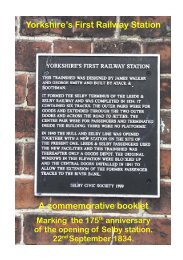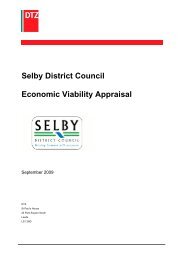Brayton - pdf - Selby District Council
Brayton - pdf - Selby District Council
Brayton - pdf - Selby District Council
You also want an ePaper? Increase the reach of your titles
YUMPU automatically turns print PDFs into web optimized ePapers that Google loves.
Appendix B: General Advice For<br />
Prospective Developers<br />
Appendix B: General advice for prospective<br />
developers<br />
B1 This section considers more than just the<br />
aesthetic issues and offers advice and<br />
guidance for prospective developers in<br />
achieving a suitable development proposal.<br />
General good design<br />
B2 There are lots of conflicting issues in<br />
considering new development, but whatever<br />
the compromise, the village character should<br />
always be maintained.<br />
B3 The character described in the VDS does<br />
not restrict new designs or materials or insist<br />
that everything is designed to “look old”.<br />
Instead, it is the job of the developer to design<br />
and build a modern building that satisfies<br />
modern needs, exploits new technology and<br />
building methods, and uses them to create a<br />
desirable, profitable development that works<br />
with its environment to seamlessly integrate<br />
with the local area. Modern, but appropriate<br />
development is encouraged.<br />
B4 It is helpful to consider the visual impact of<br />
developments from all angles and from longer<br />
distance. Accurate perspective (isometric)<br />
drawings or street scene views to show how<br />
new developments would appear in relation to<br />
their neighbouring properties and in the wider<br />
street scene could be very useful.<br />
B5 There is an emphasis on evolution not<br />
revolution in the village, and so multiple smaller<br />
developments will have less impact than a<br />
single large-scale development. This approach<br />
reflects the way the village has grown in the<br />
past.<br />
B6 Examples of inappropriate designs,<br />
materials and layouts within the village should<br />
not be used as a precedent for further<br />
inappropriate use of these features.<br />
The Planning Process<br />
B7 Anyone considering development should<br />
contact the <strong>District</strong> <strong>Council</strong> for planning advice<br />
before submitting an application. This will<br />
help to iron out potential issues and lead to a<br />
smoother planning process. The Parish<br />
<strong>Council</strong> would also welcome early discussion<br />
and to help wherever they can.<br />
B8 Discussion with neighbours before applying<br />
for planning permission will give them an<br />
opportunity to discuss any concerns, and that<br />
may avoid unnecessary neighbour disputes.<br />
B9 Some development does not need planning<br />
permission, but the need for good design<br />
remains. Understanding of the local character<br />
and applying it may increase the value of a<br />
development and ensure that the important<br />
local character remains.<br />
Repairs and maintenance of buildings<br />
B10 Many buildings in the villages are old,<br />
having been built long before building<br />
regulations came in to effect, before plastics<br />
were invented, and before cars began<br />
damaging structures through impact, chemical<br />
attack via exhaust gases, and water damage<br />
from splashing through puddles. The need to<br />
maintain and repair our older buildings is never<br />
more apparent, but it is essential that the<br />
correct materials and methods are used to<br />
maintain character, but also to ensure that the<br />
building continues to live.<br />
B11 Bricks and stone may be bonded together<br />
using a mortar, but up until the Great War, most<br />
buildings used a lime mortar mix rather than a<br />
sand-and-cement mortar used today. Cement<br />
mortar is extremely hard and does not flex<br />
which can lead to cracks appearing, particularly<br />
where foundations are shallow or soft. The<br />
rain cannot penetrate cement easily and so it is<br />
found that the bricks and stone wear out faster<br />
than the mortar joints leaving the mortar<br />
exposed. This accelerates wear and<br />
buildings will become damp, unstable and<br />
ultimately collapse. A lime mortar is no more<br />
expensive and no more difficult to use than<br />
cement, but it is the better choice for many<br />
buildings in the district. Where stone is used,<br />
a sand and cement mortar should never be<br />
used.<br />
B12 When installing modern features on a<br />
traditional building such as satellite receiver<br />
dishes, conservatories, replacement guttering<br />
and fascias etc, new windows and doors, and
















